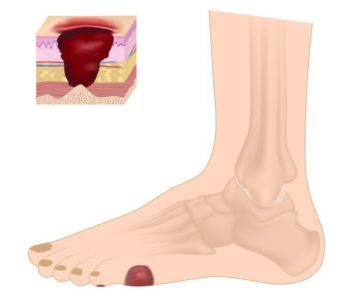 Foot ulcers are a condition categorized by a shallow opening or crater that develops on the surface of the skin. More serious cases involve deeper craters that can damage nerves, tendons and even bones. Today, we take a closer look at why ulcers develop, who is at the greatest risk for a foot ulcer, and how they can be treated so they cause the least amount of damage.
Foot ulcers are a condition categorized by a shallow opening or crater that develops on the surface of the skin. More serious cases involve deeper craters that can damage nerves, tendons and even bones. Today, we take a closer look at why ulcers develop, who is at the greatest risk for a foot ulcer, and how they can be treated so they cause the least amount of damage.
Foot Ulcer Development
Foot ulcers are essentially open wounds that develop on your foot. Since they are open wounds, ulcers are prone to infection, which can severely complicate the condition. An infected ulcer can lead to abscess development, a bone infection, gangrene (tissue death) and even the eventual loss of the foot. However, foot ulcers don’t need to become infected in order to be problematic.
Here’s a look at some of the risk factors that can cause a foot ulcer to develop:
- Diabetes
- Peripheral neuropathy (nerve damage in the feet)
- Circulatory issues
- Foot abnormalities
- Other medical conditions like atherosclerosis or Raynaud’s phenomenon
When you look at all the above causes, they all share one key aspect – lack of adequate blood flow to the feet. When healthy blood can’t get to the right areas in the feet, the healing process is severely delayed. Wounds that would normally close up and heal remain open for longer because of nerve issues and inadequate blood flow, leaving them open to infection. If you want to reduce your risk of developing a foot ulcer, talk with your doctor about how you can improve blood flow in your feet.
Symptoms and Treatment of Foot Ulcers
The most obvious symptom of a foot ulcer will be pain, especially when pressure is placed on the area when walking. However, the easiest way to spot a foot ulcer is by its appearance. A foot ulcer will traditionally be a reddish crater oftentimes on the underside of the foot or on the tip of a toe. They are usually surrounded by a border of thick, callused skin. Deeper craters will have a darker appearance, and they may be draining liquid or pus. If you can’t easily check the bottom of your feet, look for signs of discharge or discoloration on any socks you wear to help identify the problem.
If you believe you have a foot ulcer, it’s a good idea to set up a consultation with a foot specialist. Not only will they examine the ulcer itself, but they’ll get to the bottom of why you’re dealing with poor blood circulation in your feet. After determining the cause and controlling for other factors, your doctor will move forward with a treatment plan for your ulcer. Treatment often depends on whether or not the ulcer is infected, how deep the ulcer is, if the ulcer is threatening other structures and how likely it is that you’ll develop future ulcers.
If the doctor is satisfied with the circulation in your feet, they may take care of the issue with a simple debridement procedure. This involves trimming away any diseased tissue and applying a dressing to the wound to keep it clean. Your doctor will give you instructions on how to care for your foot and how to keep it clean, and you may have to return for a subsequent debridement to ensure it’s healing as expected. Sometimes an ulcer treated with debridement can heal in a couple of weeks, but other times it may take a couple of months to heal. Antibiotics will be given if an infection is present.
Foot Ulcer Surgery
If a simple debridement operation won’t do the trick, a more invasive surgery may be necessary. The goal of surgery is to improve blood flow in the leg, and this can be by clearing the artery blockage with an angioplasty operation or by rerouting blood flow with a bypass operation. These operation will be used in conjunction with a debridement operation to create the best chance of full healing. You may also receive medication to help improve your circulation. Similar to the debridement only option, full recovery can take anywhere from 3-20 weeks depending on your specific ulcer.